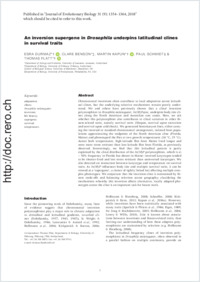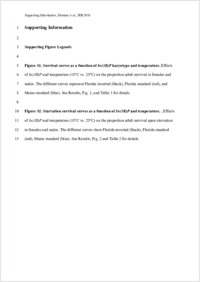An inversion supergene in Drosophila underpins latitudinal clines in survival traits
- Durmaz, Esra Department of Ecology and Evolution, University of Lausanne, Switzerland - Department of Biology, University of Fribourg, Switzerland
- Benson, Clare Department of Ecology and Evolution, University of Lausanne, Switzerland
- Kapun, Martin Department of Ecology and Evolution, University of Lausanne, Switzerland - Department of Biology, University of Fribourg, Switzerland
- Schmidt, Paul School of Biological Sciences, University of Manchester, UK - Department of Biology, University of Pennsylvania, Philadelphia, USA
- Flatt, Thomas Department of Ecology and Evolution, University of Lausanne, Switzerland - Department of Biology, University of Fribourg, Switzerland
-
01.09.2018
Published in:
- Journal of Evolutionary Biology. - 2018, vol. 31, no. 9, p. 1354–1364
English
Chromosomal inversions often contribute to local adaptation across latitudinal clines, but the underlying selective mechanisms remain poorly understood. We and others have previously shown that a clinal inversion polymorphism in Drosophila melanogaster, In(3R)Payne, underpins body size clines along the North American and Australian east coasts. Here, we ask whether this polymorphism also contributes to clinal variation in other fitness-related traits, namely survival traits (lifespan, survival upon starvation and survival upon cold shock). We generated homokaryon lines, either carrying the inverted or standard chromosomal arrangement, isolated from populations approximating the endpoints of the North American cline (Florida, Maine) and phenotyped the flies at two growth temperatures (18 °C, 25 °C). Across both temperatures, high-latitude flies from Maine lived longer and were more stress resistant than low-latitude flies from Florida, as previously observed. Interestingly, we find that this latitudinal pattern is partly explained by the clinal distribution of the In(3R)P polymorphism, which is at 50% frequency in Florida but absent in Maine: inverted karyotypes tended to be shorter-lived and less stress resistant than uninverted karyotypes. We also detected an interaction between karyotype and temperature on survival traits. As In(3R)P influences body size and multiple survival traits, it can be viewed as a ‘supergene’, a cluster of tightly linked loci affecting multiple complex phenotypes. We conjecture that the inversion cline is maintained by fitness trade-offs and balancing selection across geography; elucidating the mechanisms whereby this inversion affects alternative, locally adapted phenotypes across the cline is an important task for future work.
- Faculty
- Faculté des sciences et de médecine
- Department
- Département de Biologie
- Language
-
- English
- Classification
- Biological sciences
- License
- License undefined
- Identifiers
-
- RERO DOC 323289
- DOI 10.1111/jeb.13310
- Persistent URL
- https://folia.unifr.ch/unifr/documents/307073
Other files
Statistics
Document views: 79
File downloads:
- fla_isd.pdf: 191
- fla_isd_sm.pdf: 108

